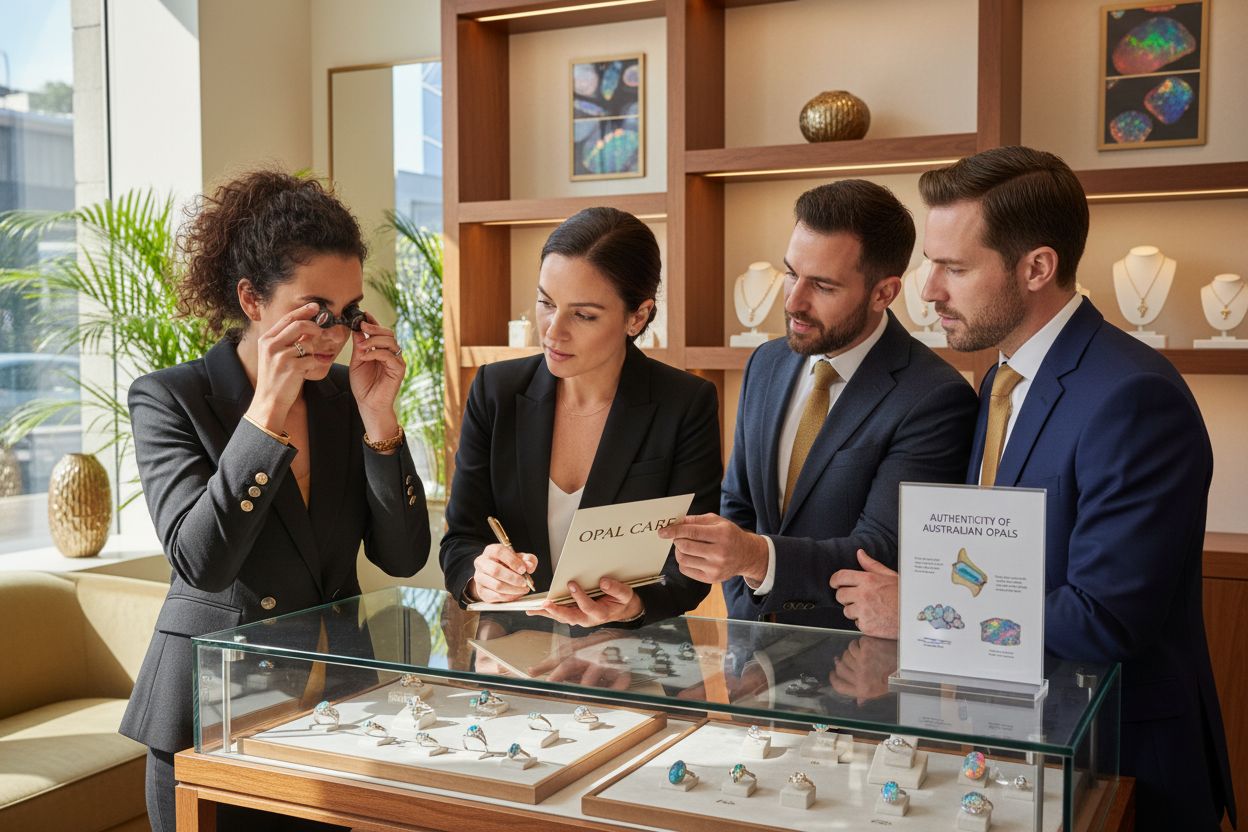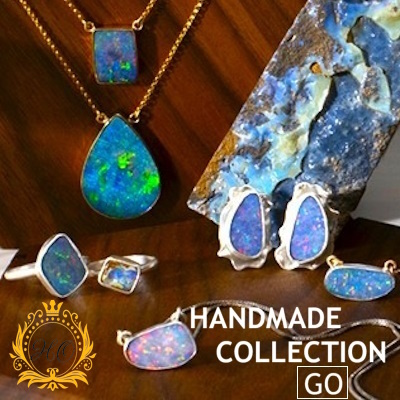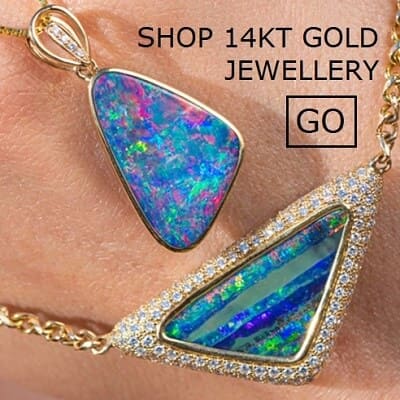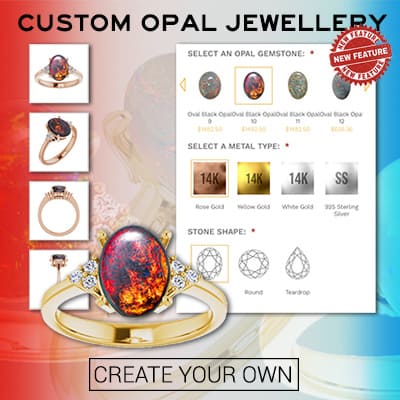7 Best Opal Jewelry Tips Every Collector Should Know
Posted by AOD on 20th Oct 2025
7 Best Opal Jewelry Tips Every Collector Should Know

Did you know that over 95 percent of the world’s precious opal comes from Australia? These stunning gemstones have captivated collectors for centuries, but finding a genuine stone with real investment value takes more than a good eye. From spotting authenticity markers to choosing the right setting and caring for your pieces, building an opal collection takes specific knowledge. Discover the essentials that set the rarest Australian opals apart and learn how to protect your collection for years to come.
Quick Summary
| Takeaway | Explanation |
|---|---|
| 1. Identify genuine Australian opals correctly. | Look for unique markers like natural imperfections and dynamic color play to distinguish authenticity. |
| 2. Choose an appropriate setting for opals. | Settings should protect and enhance opals, accommodating their delicate nature and unique properties. |
| 3. Evaluate opal color, pattern, and brightness. | Assess opals based on their color intensity, pattern complexity, and brightness for accurate valuation. |
| 4. Prioritize ethical sourcing when buying. | Ensure transparency regarding stone origin and treatment, supporting responsible mining practices. |
| 5. Follow proper care practices for opal jewelry. | Protect opals from temperature changes and store them safely to maintain their beauty and integrity. |
Table of Contents
- Identify Authentic Australian Opals
- Choose The Right Setting For Opal Jewelry
- Evaluate Opal Color, Pattern, And Brightness
- Understand Ethical Sourcing And Value
- Best Care Practices For Opal Jewelry
- How To Store Opal Pieces Safely
- When To Invest In Limited Edition And Custom Opals
1. Identify Authentic Australian Opals
Knowing how to identify genuine Australian opals is the first critical skill every serious collector must master. Not all opals are created equal and understanding authenticity can protect you from costly mistakes.
Authentic Australian opals have distinctive characteristics that set them apart from imitations. Read more about Australian opal origins to understand their unique geological heritage. These precious gemstones typically originate from renowned mining regions like Coober Pedy, Lightning Ridge, and Andamooka where the most prized stones emerge.
Key Authenticity Markers:
- Natural imperfections that indicate genuine formation
- Dynamic play-of-colour rather than uniform patterns
- Specific physical properties including Mohs hardness between 5.5 and 6.5
Visual examination remains crucial for determining an opal’s authenticity. Professional collectors look beyond surface appearance and evaluate critical elements such as play-of-colour intensity and pattern variations. Harlequin and pinfire patterns suggest genuine Australian origins.
To verify an opal’s authenticity, consider these practical steps: examine its color variation, check for natural inclusions, confirm its specific gravity (1.9 to 2.3), and most importantly purchase from reputable sellers who provide certification. Simple tests like light reflection, temperature response, and UV fluorescence can also provide additional verification.
Remember: Solid opals are significantly more valuable than doublets or triplets. Composite stones might look beautiful but lack the durability and investment potential of natural, earth-mined Australian opals.
2. Choose the Right Setting for Opal Jewelry
Selecting the perfect setting for your opal is more than aesthetic preference—it is about protecting and showcasing your precious gemstone’s unique characteristics. Learn how to design custom opal settings that complement each stone’s individual beauty.
Opals require specialized settings that account for their delicate nature and distinctive optical properties. Unlike harder gemstones like diamonds, opals demand careful consideration to prevent damage and maximize their stunning play-of-colour.
Critical Setting Considerations:
- Protect the stone’s vulnerable edges
- Allow maximum light interaction
- Match the setting to the opal’s specific structure
- Consider the stone’s backing and origin
Traditional cabochon cuts work exceptionally well for opals because they provide a smooth rounded surface that enhances the stone’s natural light refraction. The setting should cradle the stone securely without applying excessive pressure that might compromise its structural integrity.
For boulder opals or composite stones like doublets, the setting must accommodate the natural host rock or backing. Solid opals need different mounting approaches compared to layered stones. Bezel settings offer excellent protection by surrounding the stone’s perimeter, while prong settings can work well for stones with more structural resilience.
Professional jewelers recommend choosing settings that minimize the opal’s exposure to potential impact. Recessed or protective settings reduce the risk of chipping or scratching, ensuring your investment remains beautiful for generations. Metal selection matters too—softer metals like gold provide gentler support compared to harder platinum settings.
Remember: Your opal’s setting is its guardian and showcase. A thoughtfully chosen setting transforms a beautiful gemstone into an extraordinary piece of wearable art.
3. Evaluate Opal Color, Pattern, and Brightness
Understanding an opal’s visual characteristics is like deciphering a unique fingerprint of nature. Explore the fascinating world of opal types to appreciate the complexity behind these mesmerizing gemstones.
Opals are renowned for their extraordinary play-of-colour—a dynamic optical phenomenon that sets them apart from other gemstones. Professional collectors assess three critical elements: color, pattern, and brightness to determine an opal’s true value.
Key Evaluation Criteria:
- Color intensity and diversity
- Distinctive pattern characteristics
- Light reflection and brilliance
- Angle-dependent color visibility
Color plays a paramount role in opal valuation. Red hues are exceptionally rare and command higher prices compared to more common blue tones. The most sought-after opals display vibrant colors visible from multiple viewing angles, creating a captivating visual experience.
Pattern complexity significantly impacts an opal’s desirability. Rare configurations like harlequin (characterized by rectangular color blocks) and rainbow patterns are prized by serious collectors. Conversely, opals with extensive dead spots—areas lacking color play—see reduced market value.
Brightness serves as a critical grading metric, ranging from dull to brilliant. Brilliant opals demonstrate intense color reflection and remarkable light interaction. Professional gemologists use standardized scales to assess an opal’s luminosity, recognizing that viewing conditions like light source and observation angle dramatically influence perceived brightness.
When evaluating an opal, examine it under various lighting conditions. Natural daylight provides the most accurate representation of its true character. Rotate the stone to observe color shifts and assess its dynamic play-of-colour.
Pro Tip: The most valuable opals tell a visual story—each stone is a unique canvas painted by geological processes over millions of years.
4. Understand Ethical Sourcing and Value
Ethical opal collecting goes far beyond aesthetic appreciation—it represents a commitment to responsible gemstone acquisition and preservation of geological heritage. Learn more about the rich history and symbolism of opals to understand their deeper significance.
The world of opal procurement is complex and requires discerning collectors to look beyond surface beauty. Responsible sourcing means understanding an opal’s complete journey from earth to jewelry box.
Ethical Sourcing Principles:
- Transparency about stone origin
- Clear disclosure of treatment processes
- Support for responsible mining practices
- Verification through professional associations
Reputable sellers who are members of organizations like the Opal Association of Australia demonstrate commitment to industry standards. They provide comprehensive information about an opal’s geographical origin, mining conditions, and any enhancement treatments applied to the stone.
Value determination extends beyond visual appeal. Solid Black and White opals represent premium investments due to their rarity and durability. These stones are ideal for creating heirloom pieces that can be passed through generations. In contrast, doublets and triplets—composite stones created by layering opal fragments—offer more affordable alternatives but carry less long term value and structural integrity.
When evaluating an opal’s ethical credentials, consider asking sellers specific questions about sourcing. Transparent vendors will readily share details about mining locations, extraction methods, and any treatments performed on the stone. This approach not only ensures you receive an authentic product but also supports responsible industry practices.
Pro Tip: An ethically sourced opal tells a story—not just of geological wonder but of responsible stewardship. Your purchase can support sustainable mining communities and preserve these extraordinary natural treasures.
5. Best Care Practices for Opal Jewelry
Preserving the brilliance of your opal jewelry requires more than casual maintenance—it demands precision and understanding. Explore our comprehensive guide to opal care and handling to protect your precious gemstones.
Opals are delicate treasures that respond dramatically to environmental conditions. Their unique composition makes them sensitive to moisture, temperature fluctuations, and mechanical stress. Understanding their nuanced care requirements is crucial for maintaining their extraordinary beauty.
Essential Opal Care Strategies:
- Avoid extreme temperature changes
- Protect from direct sunlight and heat
- Store separately from harder gemstones
- Clean with soft cloths and minimal moisture
- Remove before physical activities
Temperature and moisture management are fundamental to opal preservation. These gemstones have a remarkable ability to remain stable under moderate environmental changes. However, synthetic opals might demonstrate significant appearance alterations under similar conditions.
When cleaning your opal jewelry, use gentle techniques. Soft microfiber cloths work best for removing surface dust. Avoid ultrasonic cleaners or harsh chemical solutions that could compromise the stone’s intricate structure. Professional jewelers recommend periodic professional cleaning to maintain the opal’s optimal condition.
Storage plays a critical role in opal conservation. Always store individual pieces in soft fabric pouches or separate compartments to prevent scratching. Keep your opals away from direct sunlight and heat sources which can cause internal structural changes or color fading.
Pro Tip: Think of your opal like a living artifact. Each piece carries geological memory and requires gentle, thoughtful care to preserve its unique storytelling capabilities.
6. How to Store Opal Pieces Safely
Opal storage is an art form that requires precision and understanding of these delicate geological treasures. Discover the fascinating geological history behind opals to appreciate their remarkable fragility.
The storage environment plays a critical role in preserving your opal jewelry’s structural integrity and visual brilliance. These sensitive gemstones react dramatically to environmental conditions, making thoughtful storage an essential practice for serious collectors.
Critical Storage Guidelines:
- Maintain consistent humidity levels
- Avoid extreme temperature fluctuations
- Use soft fabric storage solutions
- Separate opals from harder gemstones
- Keep away from direct sunlight
Moisture management is paramount when storing opals. Sudden humidity changes can compromise their structural composition. Sealed environments that are too dry might cause dehydration and potential cracking. The ideal storage solution provides a stable environment with moderate humidity.
Composite opals like doublets and triplets demand extra caution. These layered stones are more susceptible to delamination when exposed to heat or moisture. Solid natural opals prove more resilient but still require careful handling. Professional collectors recommend individual soft fabric pouches or dedicated compartments in jewelry boxes to prevent scratching and minimize environmental stress.
Temperature stability is another crucial factor. Avoid storing your opals near heating vents, windowsills, or areas with significant temperature variations. A consistent cool environment helps maintain the stone’s natural characteristics and prevents potential structural damage.
Pro Tip: Think of your opal storage like protecting a rare manuscript. Each piece carries geological memory that can be preserved through mindful, gentle care.
7. When to Invest in Limited Edition and Custom Opals
Not all opals are created equal—some transcend mere jewelry and become rare geological investments. Learn the fascinating details about Black Opals to understand their unique investment potential.
Investing in limited edition and custom opals requires a strategic approach that balances aesthetic appreciation with potential future value. These extraordinary gemstones represent more than beautiful accessories—they are tangible geological artifacts with remarkable investment characteristics.
Strategic Investment Criteria:
- Verify geographic origin
- Assess rarity of pattern and color
- Consider long term scarcity
- Obtain professional laboratory certification
- Analyze historical value trends
Solid Black opals are experiencing increasing scarcity in the global market. Collectors who acquire high quality natural specimens today are positioning themselves for significant long term value appreciation. Large or uniquely patterned opals from renowned localities like Lightning Ridge command premium prices and represent exceptional investment opportunities.
Before committing to a limited edition opal, conduct thorough due diligence. Professional laboratory analysis can verify critical factors such as geographic origin, precise composition, and complete treatment history. These comprehensive assessments provide transparency and validate the stone’s potential future value.
Custom opals offer another compelling investment avenue. Pieces featuring rare color combinations or extraordinary play-of-colour characteristics can appreciate substantially over time. Seek opals with documented provenance and minimal treatment to maximize potential returns.
Pro Tip: Think of exceptional opals as geological time capsules—each stone tells a story that grows more valuable with careful preservation and understanding.
Below is a comprehensive table summarizing the key points on identifying, caring for, and investing in Australian opals as discussed in the article.
| Aspect | Details | Key Considerations |
|---|---|---|
| Identifying Authentic Opals | Distinctive characteristics like natural imperfections, dynamic play-of-color, and specific gravity. | Analyze color variation, patterns like harlequin and pinfire, and buy from reputable sellers. |
| Choosing Jewelry Settings | Specialized settings for delicate stones, such as cabochon cuts or bezel settings. | Ensure protection and showcase optical properties, avoid pressure. |
| Evaluating Opal Qualities | Color, pattern, brightness, and angle-dependent visibility. | Red hues are rare; vibrant colors fetch higher value. |
| Ethical Sourcing | Support transparent sourcing and responsible mining. | Verify through professional associations, focus on long-term value. |
| Care Practices | Avoid extreme temperatures, use soft cloths, and store separately. | Store in moderate humidity; gentle cleaning is essential. |
| Storage Guidelines | Maintain consistent humidity, avoid sunlight. | Use soft fabric pouches, separate from harder gems. |
| Investing in Opals | Verified origin, rarity, and certification. | Solid Black opals are premium investments; custom opals with rare patterns can appreciate in value. |
Discover Authentic Opals That Match Your Collector’s Standards
Looking to put the article’s expert tips into action and avoid the disappointment of imitation stones or poorly set opal jewelry? When your goal is to secure genuine Australian opals and design pieces that last for generations, the search for trusted sources can be overwhelming. This article highlights the importance of authenticity, ethical sourcing, and specialized care—and those same challenges are at the heart of the Australian Opal Direct experience.

See the difference that direct-miner relationships and transparent sourcing make. Shop real, earth-mined treasures from Australia’s iconic Lightning Ridge and Coober Pedy, all with certification, story, and direct sourcing to guarantee your confidence. If you want gold and silver opal jewelry or custom pieces that capture your personal vision, Australian Opal Direct offers a collection crafted for serious collectors. Visit today to explore rings, pendants, or custom jewelry with guaranteed authenticity. This is your opportunity to own a unique story in stone—start your collection now before rare pieces are gone.
Frequently Asked Questions
How can I identify authentic Australian opals?
Authentic Australian opals have natural imperfections, a dynamic play-of-colour, and a specific hardness range. Start by visually examining the stone for unblemished areas and verifying its properties, including confirming its specific gravity between 1.9 and 2.3.
What should I consider when choosing a setting for opal jewelry?
When selecting a setting for opal jewelry, prioritize the stone’s protection and light interaction. Choose a protective method like a bezel setting to cradle the opal securely and avoid any excessive pressure that could damage it.
What factors determine the value of opals?
The value of opals is primarily affected by their color intensity, pattern characteristics, and brightness. Evaluate these elements consistently and use natural daylight to assess how they shift when viewed from different angles to determine their true worth.
How should I care for my opal jewelry?
Caring for opal jewelry involves avoiding extreme temperatures and protecting them from direct sunlight. Regularly clean your opals with a soft cloth, store them separately from harder gemstones, and remove them before engaging in physical activities to prevent damage.
What are the best practices for storing opal pieces?
Store your opal pieces in a consistent environment, maintaining stable humidity and temperature levels. Use soft fabric pouches to prevent scratching and keep them away from direct sunlight, which can cause fading or cracking.
When is the best time to invest in limited edition and custom opals?
Investing in limited edition and custom opals is ideal when the stones exhibit rare patterns and colors with long-term scarcity potential. Evaluate the opals’ geographical origin and consider those with documented provenance to maximize your investment potential.
Recommended
- 7大经典澳宝首饰推荐,收藏家和珠宝爱好者必看指南 - Australian Opal Direct
- Opal Stone 101: History, Symbolism, and Uses - Australian Opal Direct
- Blog - Australian Opal Direct
- How to Design Custom Opal Rings for Luxury Jewelry Lovers - Australian Opal Direct
- 7 Types of Luxury Jewelry Every Stylish Woman Should Know – The Noble Thread




